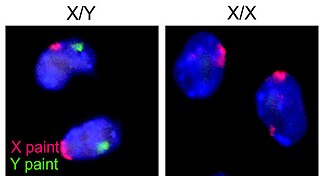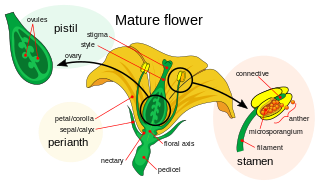
A gamete is a haploid cell that fuses with another haploid cell during fertilization in organisms that reproduce sexually. Gametes are an organism's reproductive cells, also referred to as sex cells. The name gamete was introduced by the German cytologist Eduard Strasburger in 1878.

A gametophyte is one of the two alternating multicellular phases in the life cycles of plants and algae. It is a haploid multicellular organism that develops from a haploid spore that has one set of chromosomes. The gametophyte is the sexual phase in the life cycle of plants and algae. It develops sex organs that produce gametes, haploid sex cells that participate in fertilization to form a diploid zygote which has a double set of chromosomes. Cell division of the zygote results in a new diploid multicellular organism, the second stage in the life cycle known as the sporophyte. The sporophyte can produce haploid spores by meiosis that on germination produce a new generation of gametophytes.

Meiosis (; from Ancient Greek μείωσις 'lessening', is a special type of cell division of germ cells in sexually-reproducing organisms that produces the gametes, the sperm or egg cells. It involves two rounds of division that ultimately result in four cells, each with only one copy of each chromosome. Additionally, prior to the division, genetic material from the paternal and maternal copies of each chromosome is crossed over, creating new combinations of code on each chromosome. Later on, during fertilisation, the haploid cells produced by meiosis from a male and a female will fuse to create a zygote, a cell with two copies of each chromosome again.

Fertilisation or fertilization, also known as generative fertilisation, syngamy and impregnation, is the fusion of gametes to give rise to a zygote and initiate its development into a new individual organism or offspring. While processes such as insemination or pollination, which happen before the fusion of gametes, are also sometimes informally referred to as fertilisation, these are technically separate processes. The cycle of fertilisation and development of new individuals is called sexual reproduction. During double fertilisation in angiosperms, the haploid male gamete combines with two haploid polar nuclei to form a triploid primary endosperm nucleus by the process of vegetative fertilisation.

In biology, a spore is a unit of sexual or asexual reproduction that may be adapted for dispersal and for survival, often for extended periods of time, in unfavourable conditions. Spores form part of the life cycles of many plants, algae, fungi and protozoa. They were thought to have appeared as early as the mid-late Ordovician period as an adaptation of early land plants.
A sporangium ; pl.: sporangia) is an enclosure in which spores are formed. It can be composed of a single cell or can be multicellular. Virtually all plants, fungi, and many other groups form sporangia at some point in their life cycle. Sporangia can produce spores by mitosis, but in land plants and many fungi, sporangia produce genetically distinct haploid spores by meiosis.

Alternation of generations is the predominant type of life cycle in plants and algae. In plants both phases are multicellular: the haploid sexual phase – the gametophyte – alternates with a diploid asexual phase – the sporophyte.

In botany, apomixis is asexual development of seed or embryo without fertilization. However, other definitions include replacement of the seed by a plantlet or replacement of the flower by bulbils.

An archegonium, from the Ancient Greek ἀρχή ("beginning") and γόνος ("offspring"), is a multicellular structure or organ of the gametophyte phase of certain plants, producing and containing the ovum or female gamete. The corresponding male organ is called the antheridium. The archegonium has a long neck canal or venter and a swollen base. Archegonia are typically located on the surface of the plant thallus, although in the hornworts they are embedded.

Gametogenesis is a biological process by which diploid or haploid precursor cells undergo cell division and differentiation to form mature haploid gametes. Depending on the biological life cycle of the organism, gametogenesis occurs by meiotic division of diploid gametocytes into various gametes, or by mitosis. For example, plants produce gametes through mitosis in gametophytes. The gametophytes grow from haploid spores after sporic meiosis. The existence of a multicellular, haploid phase in the life cycle between meiosis and gametogenesis is also referred to as alternation of generations.

In biology, a biological life cycle is a series of stages of the life of an organism, that begins as a zygote, often in an egg, and concludes as an adult that reproduces, producing an offspring in the form of a new zygote which then itself goes through the same series of stages, the process repeating in a cyclic fashion.

A sporophyte is the diploid multicellular stage in the life cycle of a plant or alga which produces asexual spores. This stage alternates with a multicellular haploid gametophyte phase.

In seed plants, the ovule is the structure that gives rise to and contains the female reproductive cells. It consists of three parts: the integument, forming its outer layer, the nucellus, and the female gametophyte in its center. The female gametophyte — specifically termed a megagametophyte — is also called the embryo sac in angiosperms. The megagametophyte produces an egg cell for the purpose of fertilization. The ovule is a small structure present in the ovary. It is attached to the placenta by a stalk called a funicle. The funicle provides nourishment to the ovule. On the basis of the relative position of micropyle, body of the ovule, chalaza and funicle, there are six types of ovules.

Double fertilization or double fertilisation is a complex fertilization mechanism of angiosperms. This process involves the fusion of a female gametophyte or megagametophyte, also called the embryonic sac, with two male gametes (sperm). It begins when a pollen grain adheres to the stigmatic surface of the carpel, the female reproductive structure of angiosperm flowers. The pollen grain begins to germinate, forming a pollen tube that penetrates and extends down through the style toward the ovary as it follows chemical signals released by the egg. The tip of the pollen tube then enters the ovary by penetrating through the micropyle opening in the ovule, and releases two sperm into the embryonic sac (megagametophyte).

Microspores are land plant spores that develop into male gametophytes, whereas megaspores develop into female gametophytes. The male gametophyte gives rise to sperm cells, which are used for fertilization of an egg cell to form a zygote. Megaspores are structures that are part of the alternation of generations in many seedless vascular cryptogams, all gymnosperms and all angiosperms. Plants with heterosporous life cycles using microspores and megaspores arose independently in several plant groups during the Devonian period. Microspores are haploid, and are produced from diploid microsporocytes by meiosis.

Megaspores, also called macrospores, are a type of spore that is present in heterosporous plants. These plants have two spore types, megaspores and microspores. Generally speaking, the megaspore, or large spore, germinates into a female gametophyte, which produces egg cells. These are fertilized by sperm produced by the male gametophyte developing from the microspore. Heterosporous plants include seed plants, water ferns (Salviniales), spikemosses (Selaginellaceae) and quillworts (Isoetaceae).
Plant reproduction is the production of new offspring in plants, which can be accomplished by sexual or asexual reproduction. Sexual reproduction produces offspring by the fusion of gametes, resulting in offspring genetically different from either parent. Asexual reproduction produces new individuals without the fusion of gametes, resulting in clonal plants that are genetically identical to the parent plant and each other, unless mutations occur.
Megagametogenesis is the process of maturation of the female gametophyte, or megagametophyte, in plants. During the process of megagametogenesis, the megaspore, which arises from megasporogenesis, develops into the embryonic sac, in which the female gamete is housed. These megaspores then develop into the haploid female gametophytes. This occurs within the ovule, which is housed inside the ovary.
Sporogenesis is the production of spores in biology. The term is also used to refer to the process of reproduction via spores. Reproductive spores were found to be formed in eukaryotic organisms, such as plants, algae and fungi, during their normal reproductive life cycle. Dormant spores are formed, for example by certain fungi and algae, primarily in response to unfavorable growing conditions. Most eukaryotic spores are haploid and form through cell division, though some types are diploids or dikaryons and form through cell fusion. This type of reproduction can also be called single pollination.

Sexual reproduction is a type of reproduction that involves a complex life cycle in which a gamete with a single set of chromosomes combines with another gamete to produce a zygote that develops into an organism composed of cells with two sets of chromosomes (diploid). This is typical in animals, though the number of chromosome sets and how that number changes in sexual reproduction varies, especially among plants, fungi, and other eukaryotes.













